

Photo: Telegram/ Valentyn Reznichenko
The public organization for environmental protection, Enough Poisoning Kryvyi Rih, published a video story where the activists talk about the danger of construction debris:
But there is a solution. It is how they deal in Kryvyi Rih with construction waste:
Прем’єр-міністр України Денис Шмигаль поінформував про підсумки візиту цього тижня української делегації до Сполучених Штатів… Читати більше
Із 1 липня 2025 року в Україні почнуть діяти стандарти якості електроживлення, гармонізовані із європейськими… Читати більше
У Сантьяго, в бібліотеці Культурного центру Лас-Кондес муніципалітету Лас-Кондес, відкрили першу в Чилі "Українську книжкову… Читати більше
President Volodymyr Zelensky stated that Russia is attempting to deceive the United States and other… Читати більше
Департамент активних дій Головного управління розвідки Міністерства оборони України відкрив Ютуб-канал "Аргонавти пітьми", де публікуватиме… Читати більше
Через день після потужного вибуху в найбільшому комерційному порту Ірану в порту Шахід Раджаї в… Читати більше
Цей сайт використовує Cookies.